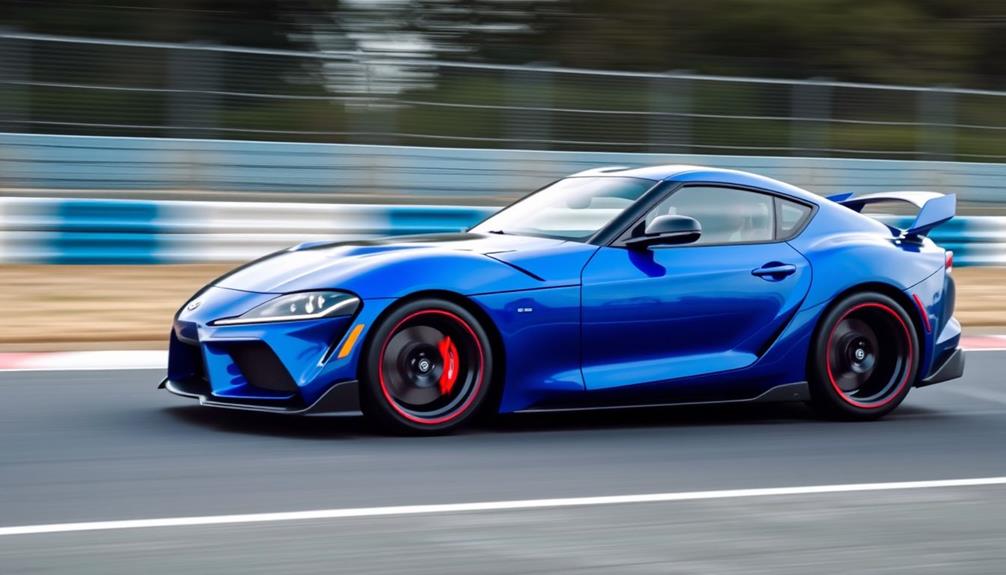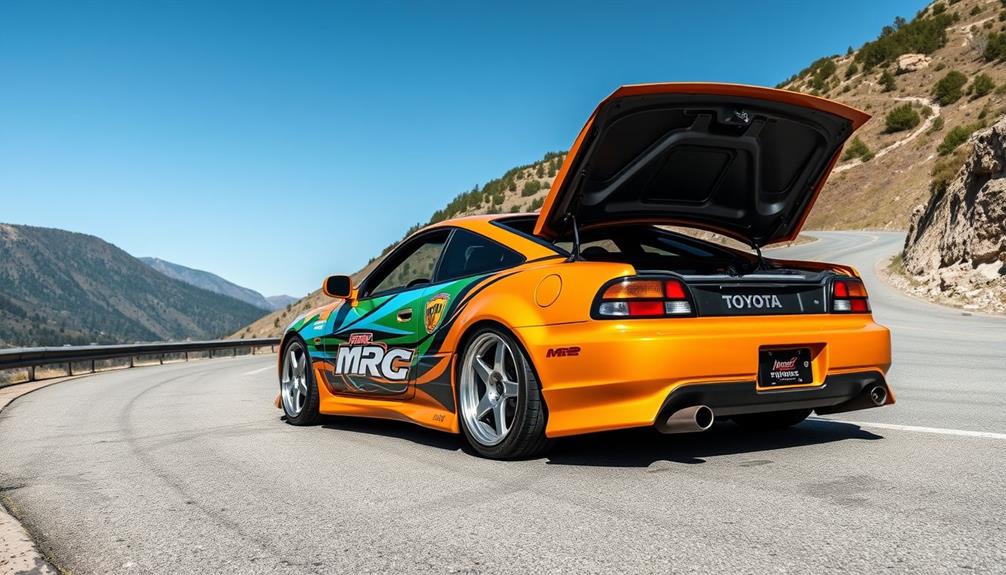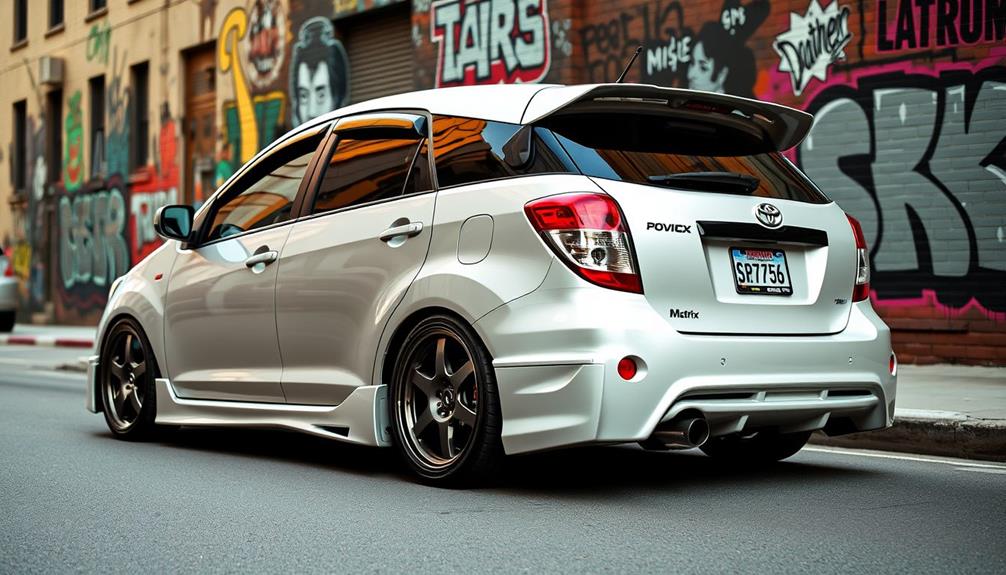To maximize power in your 2008 Toyota Scion tC, start with performance modifications like a cold air intake and a high-flow exhaust system to increase airflow and horsepower. Consider ECU tuning for significant gains, possibly boosting output by 10-40 hp. Upgrading wheels and tires improves grip, while lowering springs enhance handling and stability. Don't forget to balance your modifications; mismatched components can hinder performance. Investing in a quality performance chip can also release more potential, but be sure it's compatible with your setup. For a deeper understanding of all tuning possibilities, discover what else can elevate your driving experience.
Key Takeaways
- Upgrade the air intake system to improve airflow and boost horsepower by up to 10% for enhanced engine performance.
- Install a performance exhaust system to reduce back pressure, enhance sound, and add 7-10 hp when combined with other modifications.
- Utilize ECU remapping to increase engine output by 10 to 40 horsepower, optimizing performance across various driving conditions.
- Choose lightweight alloy wheels and high-performance tires to improve handling, grip, and overall driving dynamics for your tC.
- Consider forced induction options like superchargers or turbochargers for significant power boosts, exceeding 500whp with proper tuning.
Performance Modifications Overview
When it comes to enhancing your 2008 Scion tC's performance, what modifications should you consider? A solid performance modifications overview starts with your engine. You might want to explore options like intake systems and ECU tuning, which can greatly boost your horsepower. With the right setup, you could see gains of about 7-10 horsepower.
For a more aggressive increase, consider forced induction options like superchargers or turbochargers. These modifications can propel your tC to over 500whp, provided you've got proper tuning. Stock models typically dyno around 125-140whp, but combining intake, headers, and exhaust upgrades can elevate this to roughly 150-170whp.
Don't overlook suspension modifications, either. Many tC enthusiasts focus on a balance between power and handling. Upgrading your suspension alongside engine modifications can enhance your overall driving experience, ensuring your tC handles as well as it accelerates.
This way, you not only boost your engine's performance but also improve your ride's dynamics. Ultimately, these performance modifications will take your 2008 Scion tC to new heights, making it a more thrilling and enjoyable vehicle to drive.
Exhaust Systems Impact

Upgrading your exhaust system can considerably enhance the performance of your 2008 Scion tC. By improving exhaust flow, aftermarket exhaust systems can boost horsepower and torque, potentially adding 7-10 hp when combined with intake and header modifications.
The stock exhaust configuration restricts airflow, but when you opt for a performance exhaust, especially those with a 3-inch diameter, you'll notice a significant reduction in back pressure and improved mid-range performance. Additionally, confirming that your modifications align with your overall investment strategy can help manage costs effectively and maximize the return on your performance upgrades.
Not only do these performance exhaust systems yield measurable power gains, but they also deliver a more aggressive sound that elevates your driving experience.
Headers designed specifically for the tC optimize exhaust gas flow, contributing to efficient combustion and preventing power loss from poorly designed stock headers.
To maximize the benefits of your new exhaust system, it's crucial to pair it with proper tuning. Adjusting your engine management system guarantees it takes full advantage of the increased airflow, allowing for better fuel mapping.
With the right modifications, you'll reveal the true potential of your sporty coupe, making every drive a thrilling experience.
Enhancing Handling and Suspension

To enhance your Scion tC's handling and suspension, consider a range of upgrades that can greatly improve performance.
By focusing on lowering springs, high-performance shock absorbers, and strut bars, you can optimize your car's dynamics for better cornering and stability.
Customizing your setup with coilovers and lightweight alloy wheels will also fine-tune the balance between comfort and responsiveness, elevating your driving experience.
Suspension Upgrades Overview
For those looking to enhance the handling and suspension of their 2008 Toyota Scion tC, a variety of effective upgrades can make a significant difference.
First, consider upgrading to lowering springs. This lowers your car's center of gravity, resulting in improved stability and cornering performance. Pair these springs with high-performance shock absorbers to enhance ride quality and maintain better handling across various driving conditions.
Installing strut bars is another smart move. They stiffen the chassis, reducing body roll and improving stability during turns.
If you're after more customization, coilover kits are worth exploring. They offer adjustable ride height and stiffness, allowing you to tailor your setup for different driving styles and track conditions.
Optimizing Handling Dynamics
Improving your 2008 Toyota Scion tC's handling dynamics goes beyond just suspension upgrades. One effective way is by installing lowering springs. These springs lower your car's center of gravity, enhancing stability and cornering performance during aggressive driving.
To further boost your ride, consider high-performance shock absorbers. They improve ride quality and handling, giving you better response to road conditions and increased traction.
Strut bars are another great addition; they reduce body roll and stiffen the chassis, which is essential for enhancing stability during turns—especially on the track.
If you want even more customization, look into coilovers. They offer adjustable ride height and stiffness, allowing you to fine-tune your tC's handling characteristics to match your driving style.
Common Misconceptions in Tuning
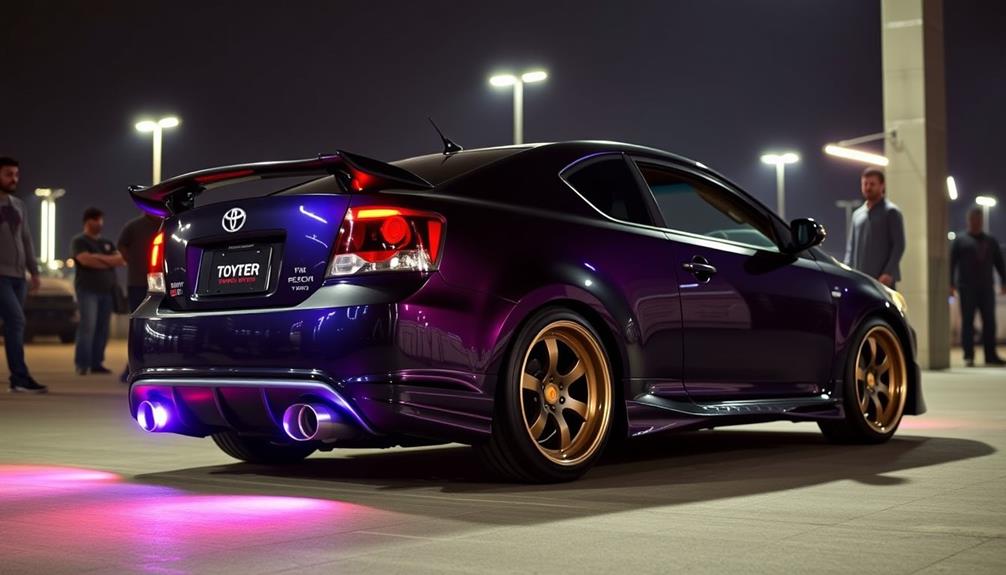
When tuning your tC, it's easy to fall for the idea that simple mods like performance chips will deliver big horsepower gains, but that's often not the case.
You might also think that all aftermarket parts will boost your speed, but balancing power enhancements with handling upgrades is essential for real performance.
Plus, don't overlook the importance of checking warranty policies before installing chips, as they can sometimes void your coverage.
Simple Mods Misunderstood
Many enthusiasts immerse themselves in tuning their Toyota Scion tC with the hope of achieving impressive horsepower gains through simple mods, but this can lead to misunderstandings. Many TC owners mistakenly believe that basic modifications, like performance chips or air intakes, will yield significant horsepower increases. Unfortunately, without thorough upgrades like forced induction, these often provide only minor gains.
It's also common to hear claims that simple exhaust modifications will drastically enhance performance. However, without proper tuning and supporting mods, the actual gains can be minimal. Many performance chips are gimmicks, disappointing those hoping for substantial power increases.
Furthermore, the belief that all aftermarket modifications are beneficial can create mismatched parts that may reduce power. Finally, younger drivers often prioritize aesthetic modifications over effective performance upgrades, which can lead to an unbalanced driving experience.
Here's a quick summary of these misconceptions:
| Misconception | Reality | Impact |
|---|---|---|
| Simple mods yield big gains | Minor gains without support | Disappointment |
| Exhaust mods drastically improve | Minimal gains without tuning | Little to no performance boost |
| All chips enhance power | Many are gimmicks | Wasted investment |
| Any mod is beneficial | Mismatched parts can hurt | Decreased performance |
| Aesthetics over performance | Balanced upgrades needed | Ineffective driving experience |
Chip Efficacy Myths
Debunking the myths surrounding performance chips is vital for any Scion tC owner looking to enhance their vehicle's performance. Many chips marketed for your tC are often considered gimmicks, providing minimal real-world gains. The chip efficacy myths suggest that you can easily boost horsepower by 10 to 40, but the truth is that actual gains largely depend on your engine's existing modifications and proper tuning.
Furthermore, just like diversifying your investment portfolio, understanding the full range of tuning options can lead to better performance outcomes. This includes considering investment strategies in precious metals as an analogy for tuning approaches, where a more thorough method yields greater benefits.
You might find that the price-to-power gain ratio for these chips isn't favorable. Instead of chasing quick fixes, consider alternative tuning methods for more significant improvements.
Additionally, there's a common misunderstanding that simply installing a performance chip will drastically enhance your vehicle's speed. In reality, you often need other supporting modifications to see meaningful results.
While some performance chips can optimize fuel and ignition systems, their overall effectiveness hinges on your specific engine setup. Engaging with the tuning community can provide valuable insights, revealing that a well-rounded approach is essential for achieving the performance you desire.
It's important to separate fact from fiction to maximize your Scion tC's potential.
Racing Dynamics Confusions
Misunderstandings about racing dynamics often stem from unrealistic expectations set by quick-fix modifications, like performance chips. Many enthusiasts believe that a simple upgrade can drastically boost their vehicle's speed, but that's rarely the case. While aftermarket chips may promise significant horsepower increases, they often lack real-world benefits, making them seem more like gimmicks than genuine enhancements.
You need to recognize that racing dynamics involve a complex interplay of various tuning aspects. Basic bolt-on parts might improve performance, but they require supporting modifications and thorough tuning to yield meaningful gains. Without a detailed approach, you'll likely find yourself disappointed when the expected performance improvements don't materialize.
The gap between what you expect and what you actually achieve can lead to confusion within the tuning community. It's essential to set realistic goals and understand how each modification affects acceleration, handling, and overall driving experience.
Educating yourself about racing dynamics will help you make informed decisions, ensuring your Scion TC 2008 tuning journey is both enjoyable and effective. Remember, tuning is a holistic process that goes beyond mere parts; it's about crafting a well-balanced performance vehicle.
Performance Chip Options

When it comes to enhancing your 2008 Scion tC's performance, exploring various performance chip options can reveal significant potential. Performance chips are an effective way to boost horsepower, improve throttle response, and enhance fuel economy. Here are some popular choices:
| Chip Type | Price | Features |
|---|---|---|
| Stage 1 Performance Chip | $99.99 | 100% money-back guarantee, releases engine potential |
| Stage 3 Performance Chip | $239.95 | Multi-core CPU, plug-and-play design for safe power maximization |
| Stage 4 Performance Chip | $299.95 | LCD monitor, advanced tuning features for significant performance boost |
| Voltage Performance Chip | $49.99 | Stabilizes voltage, compatible with other mods, real-time monitoring |
With performance chip options available, you can expect an increase in horsepower ranging from 10 to 40, depending on the model. Each chip provides unique benefits tailored to what you want from your tC. Whether you're looking for a budget-friendly option or something more advanced, there's a performance chip that fits your needs. Investing in these chips can transform your driving experience, making each ride more thrilling.
Air Intake System Benefits

Upgrading your 2008 Scion tC with a performance air intake system can markedly enhance your driving experience. By switching to a cold air intake, you can boost your horsepower and torque by up to 10%, leading to noticeably improved engine performance. This upgrade allows for higher airflow and better filtration compared to original equipment manufacturer (OEM) filters, which contributes to increased engine efficiency.
Cold air intakes are designed to draw cooler air from outside the engine bay, enhancing combustion and power output. This cooler air is denser, allowing for better combustion and consequently improving overall performance.
Additionally, installing a high-quality performance air filter, like the BMC filter, can further optimize airflow, enhancing your engine's responsiveness and acceleration.
Beyond performance, a well-designed air intake system can also enhance the auditory experience of your tC. You'll enjoy a sportier engine sound that adds to the thrill of driving.
Installation and Compatibility Insights

Installing performance upgrades on your 2008 Scion tC can considerably enhance its capabilities, but it's important to verify that each component you choose is compatible with your vehicle. Ensuring compatibility not only maximizes performance but also maintains reliability.
To achieve ideal results, consider conducting thorough keyword research to identify the best upgrades that cater to your specific needs.
Here are some insights to keep in mind during the installation process:
- Performance chips: Enjoy user-friendly, plug-and-play functionality without cutting any wires.
- Cold air intake kits: Specifically designed for your 2.4L L4 engine, boosting horsepower and torque by up to 10%.
- Exhaust systems: Require compatible headers and mid-pipes for optimal flow and power increases.
It's essential to understand that all modifications need to fit seamlessly with your vehicle's existing systems.
For instance, while voltage stabilizers connect easily to the battery, ensuring they work harmoniously with your electrical system is crucial.
If components like exhaust systems aren't compatible, you could face performance issues that negate your efforts.
Engine Tuning Techniques

Engine tuning techniques for the 2008 Scion tC can greatly enhance your vehicle's performance and driving experience. One of the most effective methods is remapping the ECU, which can provide a power increase of 10 to 40 horsepower depending on your tuning approach and any supporting modifications.
Additionally, considering a Gold IRA can provide financial stability, allowing you to invest in your car upgrades without financial stress.
To further boost engine performance, consider installing a performance air intake system. This can enhance airflow and might increase both horsepower and torque by up to 10%, especially when paired with proper tuning.
If you're serious about maximizing power, upgrading to a high-flow fuel pump and injectors is vital, particularly if you're planning to add forced induction systems like superchargers or turbochargers. These setups can push your engine's output over 300whp with the right tuning and modifications.
Lastly, it's important to regularly monitor your engine performance using diagnostic tools after tuning. This guarantees that everything's functioning effectively and helps prevent potential damage from improper settings. Regular monitoring can also alert you to any issues before they escalate into costly repairs, ensuring your vehicle’s longevity. For those specifically looking into *Toyota Camry 2017 tuning tips*, it’s crucial to keep track of air-fuel ratios and ignition timing, as these factors greatly impact both performance and fuel efficiency. Staying proactive with diagnostics will help you get the most out of your modifications while maintaining safe driving conditions.
Upgrading Wheels and Tires
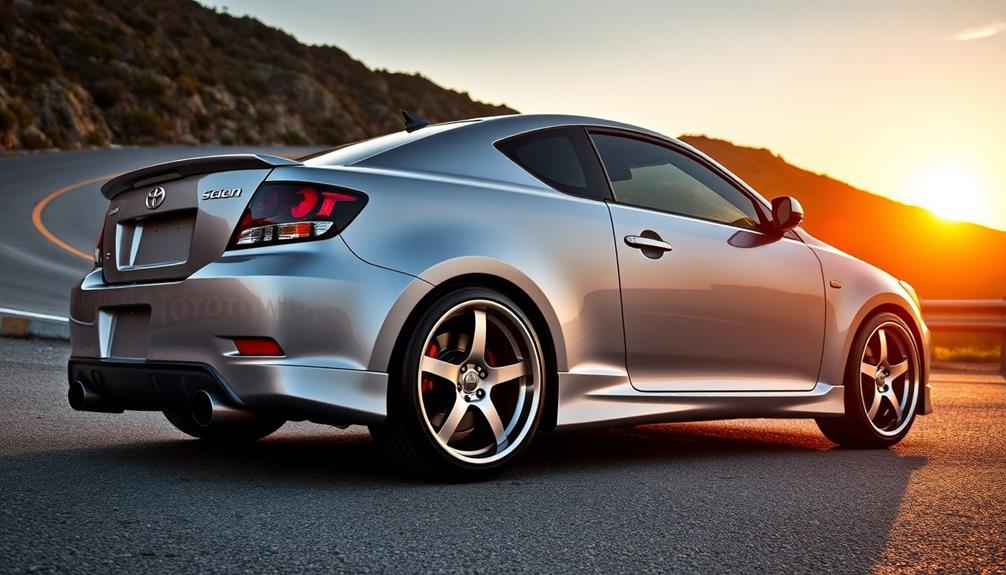
Enhancing your 2008 Scion tC's performance goes beyond just engine tuning; it also involves improving your wheels and tires for better handling and acceleration.
Upgrading wheels and tires can greatly enhance your driving dynamics, making every turn and straightaway more exhilarating.
Consider these key upgrades:
- Lightweight alloy wheels: They reduce unsprung weight, leading to improved handling and quicker acceleration.
- Wheel size: Aim for 16 inches or smaller to maintain peak performance while avoiding excessive weight that could hinder acceleration.
- High-performance tires: They enhance grip and traction, especially during cornering, allowing you to push your tC to its limits.
Additionally, opting for lower-profile tires can enhance responsiveness and minimize sidewall flex during aggressive driving.
Don't forget that proper alignment and balancing after upgrading wheels and tires are essential. This step guarantees even tire wear and maintains vehicle stability at high speeds, enhancing the overall driving experience.
Frequently Asked Questions
How Much HP Can a Scion Tc Make?
Your Scion tC can produce around 161 horsepower at the crank, translating to 125-140 wheel horsepower. With modifications like intake and exhaust, you could achieve 150-170 whp, or even more with forced induction.
Is the Scion Tc a Tuner Car?
You'd say the Scion tC is a hidden gem in the tuner world. With its vast aftermarket support and potential for upgrades, you can easily transform it into a powerful and stylish ride that turns heads.
Can You Put a Turbo in a Scion Tc?
Yes, you can install a turbo in your Scion tC. A proper turbo kit enhances horsepower considerably, but you'll need to focus on tuning and upgrading supporting components for ideal performance and engine reliability.
Is a Scion Tc Fast?
The Scion tC isn't the fastest, but it offers a sporty experience with decent acceleration. If you're looking for moderate speed and style, it's a solid choice, though extreme performance seekers might be disappointed.
Conclusion
In summary, tuning your 2008 Toyota Scion TC can transform it from a sporty coupe to a powerhouse on the road. Just like a musician fine-tuning their instrument, each modification you make enhances performance and handling, ensuring a thrilling driving experience. Whether you're upgrading the exhaust system or tweaking the engine, the right adjustments can release your car's true potential. So, immerse yourself in the world of tuning and watch your TC come alive with newfound energy!



